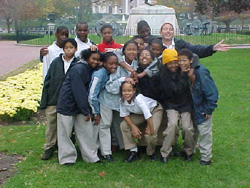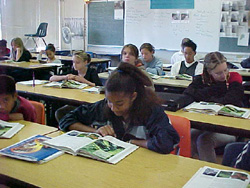REDMOND, Wash., Dec. 20, 2000 —
“My first impression when we started the Washington2Washington program was strange because I thought that I would fail the class and that it was going to be hard,”
said Yulia, a 7 th grade student at Sequoia Junior High School in Kent, Wash., as she reflected on the first quarter of Microsoft’s program connecting two classrooms in Washington, D.C. and Washington state.
“My second impression was that it would be cool and fun because I’d get to communicate with kids in Washington, D.C.”
Last fall, Microsoft helped link Yulia’s 7 th grade class at Sequoia Junior High with students at the SEED Public Charter School in Washington, D.C., for a year of interactive learning and collaboration. Since then, the two classrooms have been using technology tools both in class and online to share information and conduct peer-to-peer instruction, focusing on the subject areas represented in their geographic regions.
At each site, the students use computers donated by Dell, including OptiPlex desktop systems for the classrooms and Latitude notebook computers for field study work. Microsoft is supplying the classrooms with Microsoft Windows-powered Pocket PCs, Sony digital still and video cameras and Vernier sensors for field study in Washington state. The students are using the Windows 2000 operating system, Office 2000 productivity suite and Encarta Suite 2001, as well as Microsoft’s Windows Me operating system for video editing on two of the PCs. Students communicate online and share documents on an MSN Custom Web site, and they also communicate with each other using MSN Instant Messenger.
“The work that the teachers have done is amazing,”
said John Litten, program manager, Microsoft Youth and Learning division.
“The best thing about the program so far has been this collaboration.”
Students are responding enthusiastically to the program.
“We love the technology that we have been using,”
said Antwain, a student at the SEED School.
“We can talk to people across the United States, or even the whole world.”

Students in the Washington2Washington program from the SEED Public Charter School in Washington, D.C. pose outside the White House on a field trip.
Katie, a student at Sequoia agreed.
“The Washington2Washington program has helped me learn new things that I would never have learned. I have learned how to use more than four different pieces of digital equipment, some of which I would probably have never seen.”
According to Litten, the program been a learning experience not only for students, but also for Microsoft.
“What we’ve learned as a company is how to infuse technology into an existing program,”
he said.
“You don’t just show up in September and expect everything to work. You need to bring the technology staff in the school district on board early in the planning process. We learned that to run a program like this, we probably needed to get the technology in place six months prior to the start of school.”
To further collaboration among students in the two schools, teachers Paul Neff from Sequoia and Brandon Lloyd from the SEED School have developed a curriculum that establishes teams of students from both schools. Over the course of the school year, eight teams of five students (two from the SEED School and three from Sequoia) will work together to complete models for the development of a new country — and imaginary island, temporarily known as Generation I-Land.
According to
“Executive Order 2000 (X2K),”
an outline of the project written by Lloyd,
“the eight teams of students will each develop a proposal on how best to form the island’s government and populate the land without harm to its natural resources. In doing so, they will have to examine our present environment and government, obtain information from consultants whose expertise can contribute to their effort, and actively work with other citizens of the United States to gain an understanding of specific issues confronting different communities.”

Sequoia Middle School students in the Washington2Washington program study in their classroom in Kent, Wash.
As part of the program, the students will complete several field studies during which they will examine the environment and the government of the United States. Each field trip will provide insight into matters that are relevant to settling on Generation I-Land, while extending students’ learning beyond the classroom. Upon completion of each field trip, students will prepare a visual report using Microsoft MovieMaker, so they can share their experiences with their counterparts across the country.
Microsoft’s Washington2Washington Web site, www.microsoft.com/w2w , will showcase the students’ work throughout the school year. Educators and administrators from around the country are encouraged to review and borrow from the curriculum as the students at Sequoia and the SEED School demonstrate how learning can be enhanced through technology. At the end of the year, Microsoft plans to publish a report about the project and provide recommendations to other classrooms interested in duplicating the experience.
“As a social studies teacher, I have always struggled with creating a classroom in which students do not simply listen, copy from the board and reproduce memorized information,”
Lloyd said.
“The computers provide a resource for bringing often intangible content to life.”
Neff concurs.
“When the kids come in to class, they’re so alive,”
he said.
“There’s always a lot of excitement and they are constantly asking, ‘what are we going to do today’ and ‘what’s next.'”
At the end of the year, the students plan to visit each other’s schools. Students and teachers are looking forward to the experience.
“This project will expand their world,”
Lloyd said.
“They will become very aware that there are other people in the world who have similar but different lives.”




